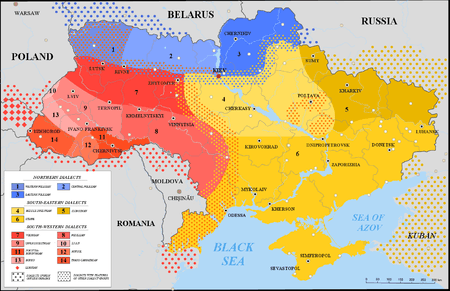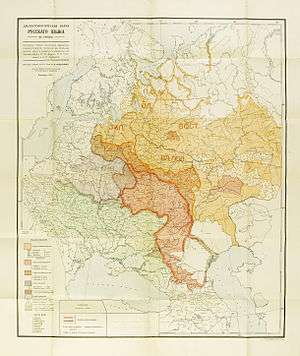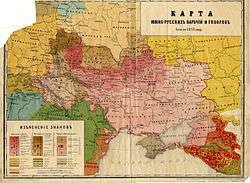Ukrainian dialects
In the Ukrainian language there are 3 major dialectal groups according to territory: the southwestern group (Ukrainian: південно-західне наріччя), the southeastern group (Ukrainian: південно-східне наріччя) and the northern group (Ukrainian: північне наріччя) of dialects.



List of dialects
Southwestern group
| Name | Description |
|---|---|
| Volhynian-Podilian dialects | |
| Podilian | spoken in the southern parts of the Vinnytsia and Khmelnytskyi Oblasts, in the northern part of the Odessa Oblast, and in the adjacent districts of the Cherkasy Oblast, the Kirovohrad Oblast and the Mykolaiv Oblast.[4] |
| Volhynian | spoken in Rivne and Volyn, as well as in parts of Zhytomyr and Ternopil. It was also spoken around Chełm (Ukrainian: Холм Kholm) in Poland. |
| Galician-Bukovyna dialects | |
| Upper Dniestrian | considered to be the main Galician dialect, spoken in the Lviv, Ternopil and Ivano-Frankivsk Oblasts. Its distinguishing characteristics are the influence of Polish and the German vocabulary, which is reminiscent of the Austro-Hungarian rule. |
| Bukovyna-Pokutia (Upper Prutian) | spoken in the Chernivtsi Oblast of Ukraine. This dialect has some distinct vocabulary borrowed from Romanian. |
| Hutsul (Western Carpathian) | spoken by the Hutsul people on the northern slopes of the Carpathian Mountains, in the extreme southern parts of the Ivano-Frankivsk Oblast, as well as in parts of the Chernivtsi and Transcarpathian Oblasts. |
| Upper Sannian | spoken in the border area between Ukraine and Poland in the San river valley. Often confused as Lemko or Lyshak. |
| Carpathian dialects | |
| Boyko | spoken by the Boyko people on the northern side of the Carpathian Mountains in the Lviv and Ivano-Frankivsk Oblasts. It can also be heard across the border in the Subcarpathian Voivodeship of Poland. |
| Lemko | spoken by the Lemko people, most of whose homeland rests outside the current political borders of Ukraine in the Prešov Region of Slovakia along the southern side of the Carpathian Mountains, and in the southeast of modern Poland, along the northern sides of the Carpathians. |
| Transcarpathian | spoken people around Uzhhorod, in the Transcarpathian Oblast. It is similar to the Lemko dialect but differs from them, because of the historical influence and integration of Slovakian and Hungarian elements. |
Southeastern group
| Name | Description |
|---|---|
| Middle Dnieprian | the basis of the Standard Literary Ukrainian. It is spoken in the central part of Ukraine, primarily in the southern and eastern part of the Kyiv Oblast). In addition, the dialects spoken in Cherkasy, Poltava and Kyiv regions are considered to be close to "standard" Ukrainian. |
| Slobozhan | spoken in Kharkiv, Sumy, Luhansk, and the northern part of Donetsk, as well as in the Voronezh and Belgorod regions of Russia.[6] This dialect is formed from a gradual mixture of Russian and Ukrainian, with progressively more Russian in the northern and eastern parts of the region. Thus, there is no linguistic border between Russian and Ukrainian, and thus, both grammar sets can be applied. This dialect is considered a transitional dialect between Ukrainian and Russian.[7] |
| Steppe | is spoken in southern and southeastern Ukraine. This dialect was originally the main language of the Zaporozhian Cossacks.[8] |
Northern group
| Name | Description |
|---|---|
| Eastern Polissian | spoken in Chernihiv (excluding the southeastern districts), in the northern part of Sumy, and in the southeastern portion of the Kyiv Oblast as well as in the adjacent areas of Russia, which include the southwestern part of the Bryansk Oblast (the area around Starodub), as well as in some areas in the Kursk, Voronezh and Belgorod Oblasts.[10] No linguistic border can be defined. The vocabulary approaches Russian as the language approaches the Russian Federation. Both Ukrainian and Russian grammar sets can be applied to this dialect. Thus, this dialect can be considered a transitional dialect between Ukrainian and Russian.[7] |
| Central Polissian | spoken in the northwestern part of the Kyiv Oblast, in the northern part of Zhytomyr and the northeastern part of the Rivne Oblast.[11] |
| West Polissian | spoken in the northern part of the Volyn Oblast, the northwestern part of the Rivne Oblast as well as in the adjacent districts of the Brest Voblast in Belarus. The dialect spoken in Belarus uses Belarusian grammar, and thus is considered by some to be a dialect of Belarusian.[12]
West Polissian dialects include Podlachian subdialects spoken in Podlachia in Poland.[13] They are also known as Siedlce dialects (because of the name of Siedlce Governorate, where the subdialects were mostly investigated),[14] and Khakhlatska mova (Ukrainian: хахлацька мова, "khokhols' language").[15] |
Emigre dialects
Ukrainian is also spoken by a large émigré population, particularly in Canada, The United States, Brazil, Argentina, and Australia. The founders of this population primarily emigrated from Galicia, which used to be part of Austro-Hungary before World War I, and belonged to Poland between the World Wars. The language spoken by most of them is based on the Galician dialect of Ukrainian from the first half of the twentieth century. Compared with modern Ukrainian, the vocabulary of Ukrainians outside Ukraine reflects less influence of Russian, yet may contain Polish or German loanwords. It often contains many loanwords from the local language as well (e.g. снікерси sneekersy, for "sneakers" in the United States[16]).
Disputed status of some dialects
Balachka
Balachka is spoken in the Kuban region of Russia, by the Kuban Cossacks. The Kuban Cossacks being descendants of the Zaporozhian Cossacks are beginning to consider themselves as a separate ethnic identity. Their dialect is based on Middle Dnieprian with the Ukrainian grammar. It includes dialectical words of central Ukrainian with frequent inclusion of Russian vocabulary, in particular for modern concepts and items. It varies somewhat from one area to another.[7]
Rusyn
The Rusyn language is considered to be a dialect of Ukrainian by Ukrainian linguists:
- Dolinian Rusyn or Subcarpathian Rusyn is spoken in the Transcarpathian Oblast.
- Pannonian or Bačka Rusyn is spoken in northwestern Serbia and eastern Croatia. Rusin language of the Bačka dialect has been recognised as one of the official languages of the Serbian Autonomous Province of Vojvodina).
- Pryashiv Rusyn is the Ukrainian dialect spoken in the Prešov (in Ukrainian: Pryashiv) region of Slovakia, as well as by some émigré communities, primarily in the United States of America.
Rusyn is considered by some Rusyn linguists and Rusyns to be a separate language:
- Rusyn has only been recently considered a Slavic literary language,[17] and was codified only recently in Slovakia in 1995. The Rusyn however varies from location to location and is influenced by the languages that are spoken nearby which can include Polish, Slovak, Hungarian, Romanian and literary Ukrainian.
See also
- Balachka
- Boiko
- Poleszuk
- Rusyn language
- Ruthenian (disambiguation)
References
- Gardiner, Sunray Cythna (1965). German Loanwords in Russian, 1550-1690. society. pp. 8.
denote White Russian.
- "Південно-західне наріччя. Українська мова. Енциклопедія". Litopys.org.ua. Retrieved 2013-01-13.
- Southwestern dialects. Internet Encyclopedia of Ukraine
- "Подільський говір. Українська мова. Енциклопедія". Litopys.org.ua. Retrieved 2013-01-13.
- "Південно-східне наріччя. Українська мова. Енциклопедія". Litopys.org.ua. Retrieved 2013-01-13.
- "Слобожанський говір. Українська мова. Енциклопедія". Litopys.org.ua. Retrieved 2013-01-13.
- http://www.ethnology.ru/doc/narod/t1/gif/nrd-t1_0151z.gif
- "Степовий говір. Українська мова. Енциклопедія". Litopys.org.ua. Retrieved 2013-01-13.
- "Північне наріччя. Українська мова. Енциклопедія". Litopys.org.ua. Retrieved 2013-01-13.
- "ІЗБОРНИК. Історія України IX-XVIII ст. Першоджерела та інтерпретації. Нульова сторінка". Litopys.org.ua. Retrieved 2013-01-13.
- "Середньополіський говір. Українська мова. Енциклопедія". Litopys.org.ua. Retrieved 2013-01-13.
- "Maps of Belarus: Dialects on Belarusian territory". Belarusguide.com. Retrieved 2013-01-13.
- Arkushyn 2019, p. 115-116.
- Lesiv 1997, p. 291.
- Arkushyn 2019, p. 118.
- "The Lexicon of the Third-Wave Ukrainian Diaspora – Forgotten Galicia". forgottengalicia.com. Retrieved 2018-10-25.
- Plišková, Anna (2008). "Practical Spheres of the Rusyn Language in Slovaka" (PDF). Studia Slavica Hung. 53 (1): 95–115. doi:10.1556/SSlav.53.2008.1.6. Retrieved 26 September 2017.
Sources
- Del Gaudio S. 2017. An introduction to Ukrainian Dialectology. Wiener Slawistischer Almanach, Sonderband 94. Frankfurt am Main etc. Peter Lang.
- Dialects of Ukrainian language
- Luckyj, George S.N. ([1956] 1990). Literary Politics in the Soviet Ukraine, 1917–1934, revised and updated edition, Durham and London: Duke University Press. ISBN 0-8223-1099-6.
- G.Y. Shevelov (1979). A Historical Phonology of the Ukrainian Language. Heidelberg: Carl Winter Verlag. ISBN 3-533-02787-2.. Ukrainian translation is partially available online.
- Григорій Петрович Півторак (Hryhoriy Pivtorak) (1998). Походження українців, росіян, білорусів та їхніх мов (The origin of Ukrainians, Belarusians, Russians and their languages). Kiev: Akademia. ISBN 966-580-082-5., (in Ukrainian). Available online.
- Subtelny, Orest (1988). Ukraine: A History. Toronto: University of Toronto Press. ISBN 0-8020-5808-6.
- Василь Німчук. Періодизація як напрямок дослідження генези та історії української мови. Мовознавство. 1997.- Ч.6.-С.3-14; 1998.
- Микола Лесюк "Різнотрактування історії української мови".
- Ilko V. Korunets' (2003). Contrastive Topology of the English and Ukrainian Languages. Vinnytsia: Nova Knyha Publishers. ISBN 966-7890-27-9.
- "What language is spoken in Ukraine", in Welcome to Ukraine, 2003, 1.
- All-Ukrainian population census 2001
- Конституція України (Constitution of Ukraine) (in Ukrainian), 1996, English translation (excerpts).
- 1897 census
- Literaturnyy Forum (Ukrainian language)
- Ukrainian–English Dictionary
- Radio Canada International daily Ukrainian language news broadcasts and transcripts
- Ukrainian Linguistic Portal
- Dialects of Ukrainian language
- Ukrainian language - the third official? - Ukrayinska Pravda, 28 November 2005
- Arkushyn, H. L. (2019). "Хахлацька мова на Підляшші" [Khakhatska language in Podlachia] (PDF). Українська мова (in Ukrainian). Луцьк (1): 115–125. ISSN 1682-3540. Retrieved 23 February 2020.CS1 maint: ref=harv (link)
- Lesiv, Mykhailo (1997). Українські говірки в Польщі [Ukrainian subdialects in Poland] (in Ukrainian). Український архів.CS1 maint: ref=harv (link)
External links
- Короткий словник львівської ґвари Upper Dniestrian